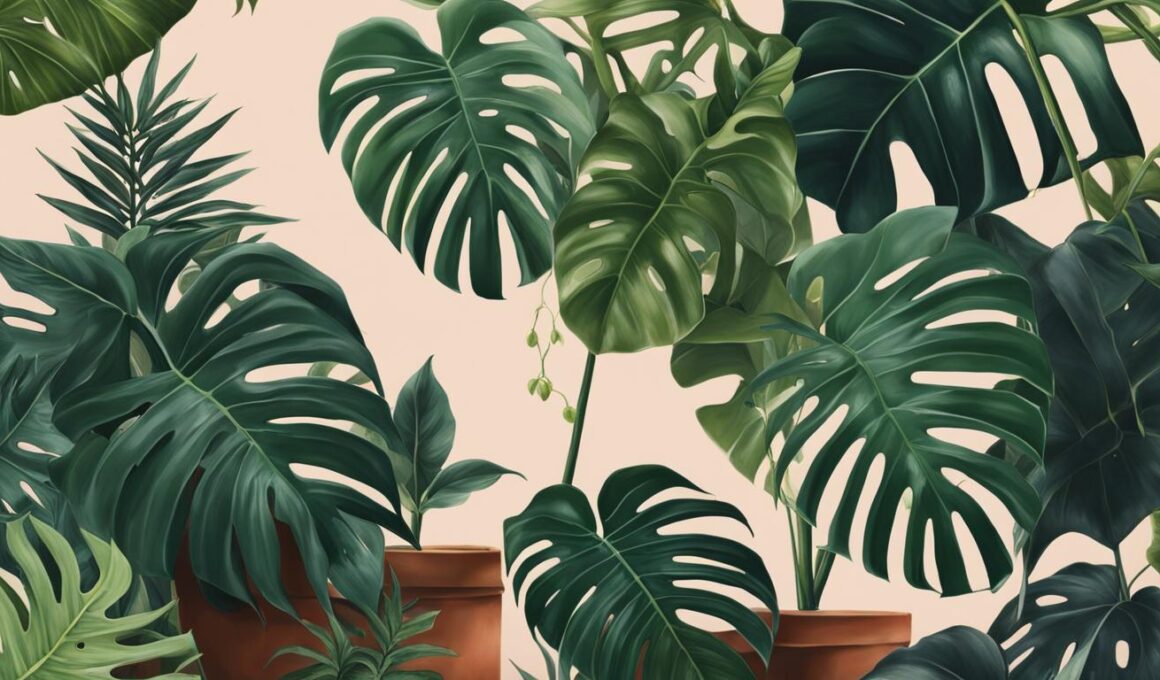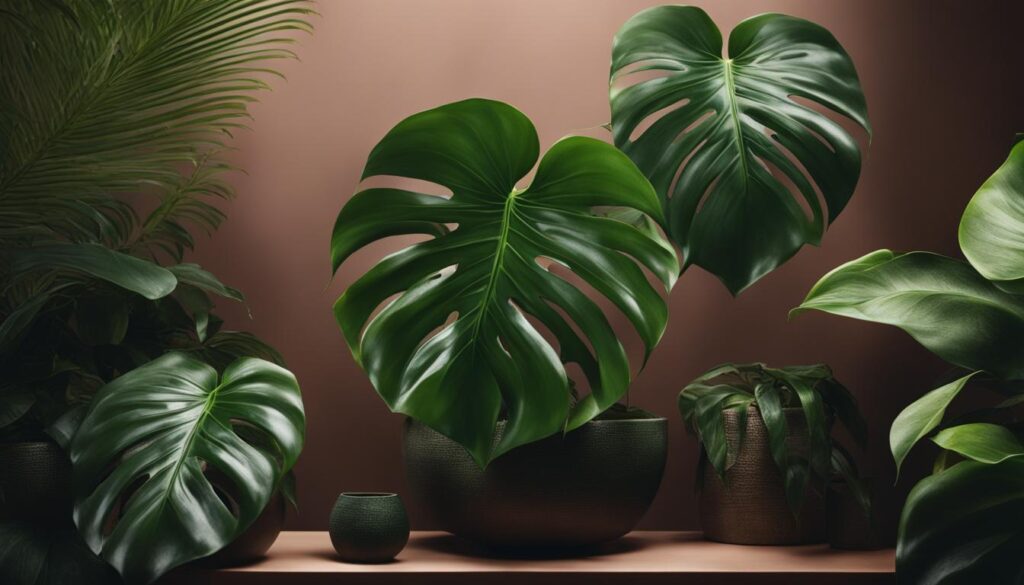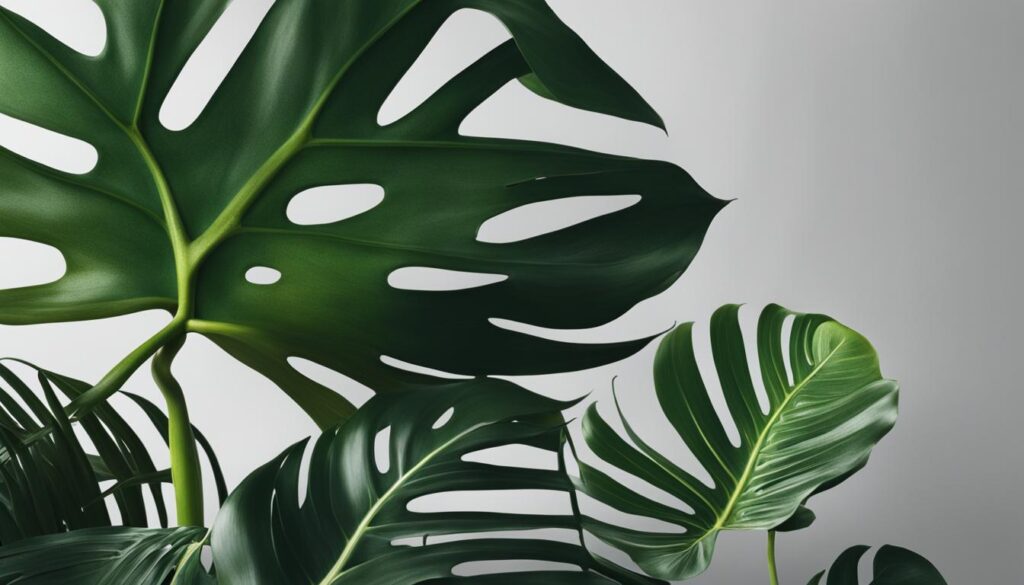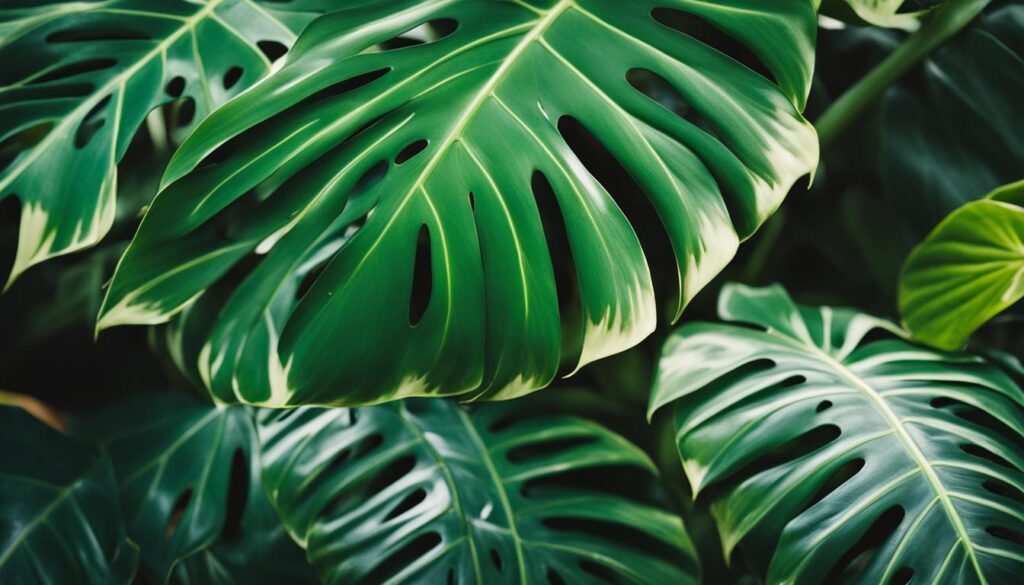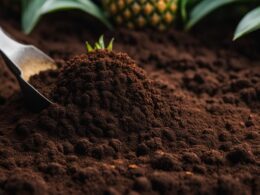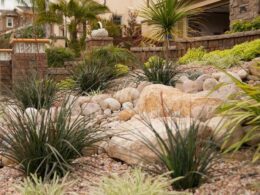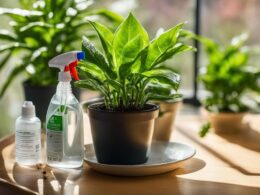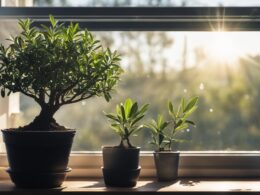As an indoor garden enthusiast, you may have encountered some confusion surrounding Monstera Deliciosa and Borsigiana when planning your houseplants collection. These popular leafy plants provide stunning aesthetics to any home design. While the taxonomy debate continues among horticulturalists, it’s essential to look at reputable sources for clarity when selecting which of these unique plants is the perfect fit for your space.
Key Takeaways
- Monstera Deliciosa and Borsigiana are popular choices for indoor gardens and home design.
- There is some debate over whether they are separate species or just variations of the same plant.
- Both plants feature fenestrated leaves and similar root systems.
- Environmental factors play a significant role in the appearance and growth patterns of Monsteras.
- Deliciosa typically has larger leaves, while Borsigiana has more controlled growth and smaller leaves.
- For accurate identification, look for differences in geniculum structure, leaf size, and growth patterns.
- Choose the Monstera type that best suits your space and design preferences.
Understanding Monstera: A Brief Overview
Originating from the tropical regions of Central and South America, Monstera plants offer a unique, striking addition to your home décor. Belonging to the Araceae family, the Monstera genus has become a favorite among gardeners and home designers alike. Their beautiful fenestrated leaves create an elegant and exotic touch in any room, making them a popular choice for those looking to add a touch of the tropics to their home.
As tropical houseplants, Monsteras require specific care in order to thrive indoors. Given proper care and attention, these gorgeous plants can become a lush, living focal point within your home.
- Light Requirements: Monsteras need bright, indirect sunlight to grow properly. Too much direct sunlight can cause the leaves to burn, while low light levels can lead to slow growth and small leaves.
- Watering: Monsteras prefer to be kept consistently moist, but not soaking wet. Water your plant when the top inch or two of soil is dry. Over-watering can lead to root rot, so be sure to use a well-draining potting mix and allow excess water to drain from the pot.
- Temperature and Humidity: As tropical plants, Monsteras thrive in warm temperatures and high humidity. Aim to keep the temperature between 65 and 85 degrees Fahrenheit and provide extra humidity through a pebble tray or by misting with water.
- Fertilizer: To encourage healthy growth, use a balanced liquid fertilizer every other week during the growing season (spring and summer) and less frequently during the colder months.
When it comes to home décor, Monstera plants can be used to create a bold statement in any room due to their large, eye-catching leaves. These exotic plants pair well with modern and minimalist styles, providing an interesting contrast between the lush green foliage and sleek interior design elements.
| Popular Monstera Species | Characteristics |
|---|---|
| Monstera deliciosa | Large, dark green leaves with deep fenestrations. Can grow up to 3ft wide. |
| Monstera adansonii | Smaller leaves with more numerous, intricate fenestrations. Often called the Swiss cheese vine due to its delicate appearance. |
| Monstera siltepecana | Silver-flecked leaves with a distinct elongated shape. A trailing species, perfect for hanging baskets or climbing displays. |
Incorporating Monstera plants in your interior design provides a lush, tropical atmosphere that can enhance any living space. As you get to know the different species within the Monstera genus, you’ll be well on your way to selecting the ideal tropical houseplant to suit your home’s aesthetic.
Key Similarities Between Monstera Deliciosa and Borsigiana
Both Monstera Deliciosa and Monstera Borsigiana possess noteworthy traits that make them much sought-after additions to any home. This section will outline their key similarities with reference to leaf structure, root system, adaptability to environmental factors, and overall aesthetic appeal in home design.
The Shared Characteristics of Leaves and Roots
When it comes to leaf structure, Monstera Deliciosa and Borsigiana share dark green, cordate-shaped leaves with oblong or semi-round cuts, also known as fenestrations. These distinctive fenestrations give the plants an exotic appearance and contribute to their ability to adapt to changing environmental conditions.
The root system of both species features aerial adventitious roots that aid in various essential functions such as moisture absorption, air exchange, nutrient uptake, and propagation. This characteristic allows them to thrive on trees and walls, further enhancing their versatility for home design.
The Impact of Environmental Factors on Growth
Both Monstera Deliciosa and Borsigiana demonstrate remarkable environmental adaptability when it comes to their growth and appearance. Factors such as age, growing conditions, and other variables significantly influence the size of their leaves and overall growth rate. Consequently, it is important to understand that differences often attributed to the species might simply reflect a plant’s response to its indoor or outdoor environment.
Their adaptability in response to environmental conditions is a testament to the versatility of Monstera plants in home design and cultivation. To better illustrate this point, consider the following table:
| Environmental Factor | Impact on Monstera Deliciosa | Impact on Monstera Borsigiana |
|---|---|---|
| Light | Prefers bright, indirect light | Prefers bright, indirect light |
| Temperature | Thrives in 65-85°F (18-29°C) | Thrives in 65-85°F (18-29°C) |
| Humidity | Prefers high humidity, benefits from misting | Prefers high humidity, benefits from misting |
| Soil | Well-draining soil mix with peat, perlite, or orchid bark | Well-draining soil mix with peat, perlite, or orchid bark |
The Aesthetic Appeal in Home Design
Monstera Deliciosa and Borsigiana both possess fenestrated leaves that make them highly desirable for home design. They effortlessly exude a sense of pristine elegance and are often featured prominently in various interior design settings. Additionally, their ability to thrive in different growing conditions makes them an adaptable and practical choice. As such, both species can successfully enhance the beauty of the areas they occupy, offering an eye-catching focal point for any room.
Decoding the Differences: Deliciosa Vs Borsigiana
Although Monstera deliciosa and Monstera borsigiana share many similarities, they also exhibit some key differences that set them apart. These distinctions can be observed in their geniculum structure, leaf size, and growth habits.
One of the distinguishing factors between Monstera deliciosa and Monstera borsigiana is their geniculum structure. The geniculum, a unique part of these plants, is a knobby joint found at the base of each leaf. The function of the geniculum is to provide the petiole with flexibility, allowing the plant to rotate its leaves and follow the sun for optimal light absorption. Deliciosa usually has a more wrinkled, pronounced geniculum compared to the smoother, straighter geniculum found on Borsigiana plants.
- Leaf Size
Another clear difference between the two species is their leaf size. Monstera deliciosa showcases larger leaves that can reach up to 3ft in diameter, producing a more striking appearance. Conversely, Monstera borsigiana has relatively smaller leaves that are usually less than 2ft in diameter.
- Growth Habits
Monstera deliciosa and Monstera borsigiana exhibit distinct growth habits. Deliciosa tends to grow more slowly and in a sprawling manner, potentially reaching a height of up to 30ft, while borsigiana demonstrates more controlled and upward growth with the right support. Moreover, the stem structure varies between the two plants, as Borsigiana exhibits greater space between nodes compared to Deliciosa.
| Species | Geniculum Structure | Leaf Size | Growth Habits |
|---|---|---|---|
| Monstera Deliciosa | Wrinkled | Up to 3ft | Slow, sprawling growth |
| Monstera Borsigiana | Straight and smooth | Less than 2ft | Controlled, upward growth |
In addition to these differences, Monstera deliciosa and Monstera borsigiana have contrasting economic implications. Deliciosa plants are generally priced higher, due to their slower growth rate and larger leaves, while the comparatively faster-growing borsigiana plants tend to be more affordable.
To sum up, by paying close attention to geniculum structure, leaf size, and growth habits, one can distinguish between Monstera deliciosa and Monstera borsigiana. Understanding these differences can help you make an informed decision when selecting the ideal Monstera plant for your indoor garden or living space.
How to Identify Monstera Types: Expert Insights
Accurate Monstera identification can be challenging due to the numerous similarities between Monstera deliciosa and Monstera borsigiana. However, focusing on specific features, such as the geniculum and growth patterns, can shed light on the differences between the two. In this section, we’ll explore the characteristics and growth patterns that help distinguish between Monstera deliciosa and Monstera borsigiana.
Distinguishing Features and Growth Patterns
Honing in on the geniculum differences is a vital aspect of Monstera identification. In mature Monstera plants, deliciosa will have a wrinkled geniculum, while borsigiana will have a straight one. However, it’s essential to note that juvenile plants may not possess a developed geniculum, making identification more challenging in younger specimens.
Another crucial factor in Monstera identification is the growth patterns of the plants. Monstera deliciosa typically exhibits sprawling growth, which contrasts with the more vine-like, controlled growth of Monstera borsigiana. Borsigiana can be trained to grow in a specific direction with the help of stakes or a support structure.
Comparing the stem node spacing can also provide insight into Monstera identification. Deliciosa’s nodes are closer together, a feature that can help differentiate it from borsigiana, which has more space between nodes.
| Characteristic | Monstera Deliciosa | Monstera Borsigiana |
|---|---|---|
| Geniculum | Wrinkled | Straight |
| Growth Pattern | Sprawling | Vine-like, controlled |
| Node Spacing | Closer together | More space between nodes |
By focusing on these distinguishing features and growth patterns, you can accurately identify the Monstera types and select the right one for your home or garden.
What Are the Key Differences Between Monstera Deliciosa and Monstera Borsigiana?
Monstera deliciosa and Monstera borsigiana both belong to the same family but have distinct differences between sempervivum and echeveria. The main variations lie in their size and leaf shape. While deliciosa leaves are larger and deeply cut, borsigiana leaves are smaller and have more holes.
Choosing the Perfect Monstera for Your Home
When it comes to selecting the ideal Monstera plant to incorporate into your home gardening or interior design plans, taking the nuances between Monstera deliciosa and Borsigiana into account can make all the difference. As discussed in this article, the subtle differences in leaf size, growth habits, and geniculum structure can play a significant role in determining which species best fits your space and design preferences.
Both Monstera deliciosa and Borsigiana offer distinct, visually striking appearances that are sure to elevate your indoor garden space. As adaptable and grand, these plants will leave a lasting impression on anyone who encounters them. So before you add a Monstera to your home, revisit the distinguishing features and characteristics of each type to make an informed decision.
Regardless of the Monstera type you ultimately choose, providing proper Monstera care is essential to maintaining the health and beauty of your new plant addition. Keep in mind their native tropical environment and provide ample lighting, humidity, and care to ensure they thrive within your living space. By understanding the unique qualities of Monstera deliciosa and Borsigiana, you can confidently showcase their beauty and create a captivating focal point in your home.





